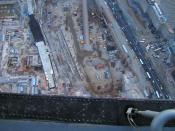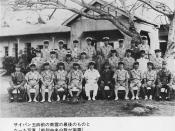The tiny atoll of Midway was the most westerly of U.S. bases in the Central Pacific. Only 1,500 miles from Oahu, it was a perfect starting point for aconquest of Hawaii. If the base was threatened by Japan, Yamamoto reasoned, the U.S. Fleet would have to meet the challenge and could be lured into a hopeless battle with superior Japanese forces.
Yamamoto planned the mother of naval battles. Some 200 ships would participate, burning more oil in this mission than the entire peacetime navy used in a year. First, an invasion of the Aleutian Islands, 1,200 miles north of Midway. Next, planes from Admiral Nagumo's four carriers would strike Midway. Japanese marines would rush ashore and capture Midway's triangular airstrip. When the U.S. Fleet rushed out in defense, it would be crushed by the most powerful armada in history.
For more than five months, the Japanese Navy had triumphed.
It had staged lightning strikes from Hawaii to Ceylon, losing no vessel larger than a destroyer. Smug with success, naval officers planned for Midway with a confidence that bordered on recklessness. They suffered, they would later admit, from "victory disease." At naval tabletop exercises held in May, the rules were bent to ensure victory, including the miraculous and unrealistic resurrection of sunken Japanese ships. Objections were swept aside. "It's pointless and impossible," said a Hiryu officer. "But Yamamoto's set on it, so there's nothing more to say."
What Yamamoto still didn't know was that Admiral Nimitz was reading his thoughts. For weeks, U.S. Intelligence had known the Japanese were planning something big. Only the target, whose code letters were "AF", was unclear. Following a hunch, the Navy had Midway broadcast a fake message, complaining about the breakdown of its distillation plant. The Japanese bit the bait. Two days later, U.S.


